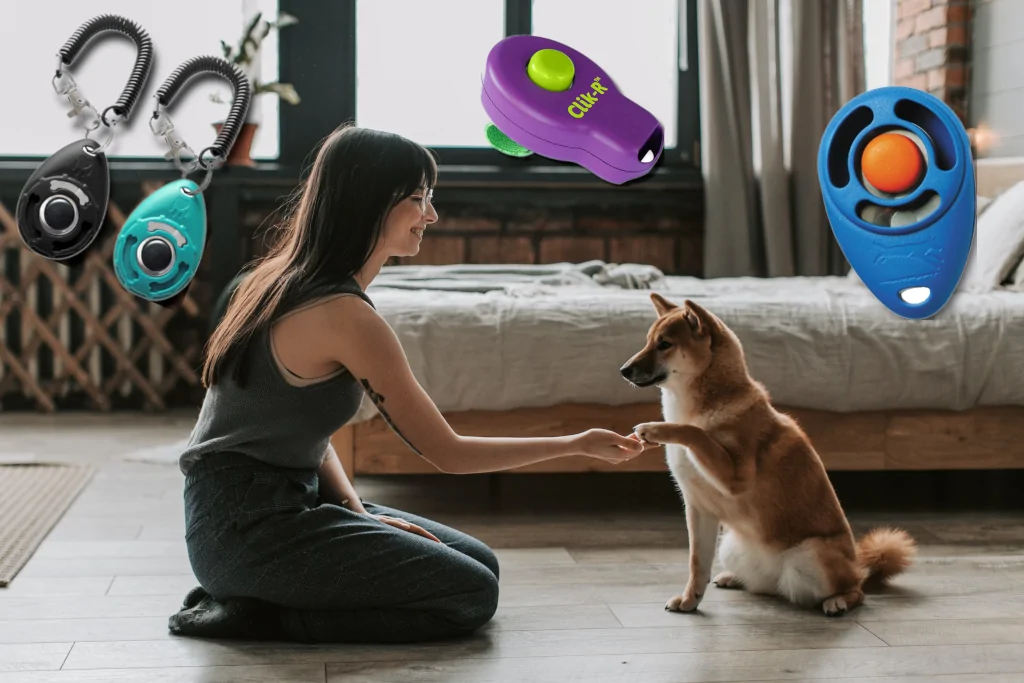Disclosure: We may earn a commission from helpful, relevant links in our content. No cost to you. See our privacy policy.
As dog owners, we’ve all been there – struggling to find the right tools for training our furry friends, and wishing for a simple, effective way to teach them new tricks.
Clickers can be a game-changer in these situations, but with so many options available, how do you choose the perfect one for your dog?
In this blog post, we’ll help you navigate the world of dog clickers and find the one that’s just right for both you and your pup. So, buckle up and get ready to click your way to a well-trained, happy canine companion!
Related guides:
Picking the Perfect Dog Training Collar
Choosing the Right Dog Training Leash
Choosing the Right Dog Training Harness

Why Use a Clicker for Your Dog?
Clicker training is a powerful, science-backed method that uses positive reinforcement to shape your dog’s behavior.
By using a clicker, you can communicate with your dog in a precise, consistent manner, allowing them to understand exactly what you want from them.
It’s a great way to build a strong bond with your pup while making the training process fun and engaging. The beauty of clicker training lies in its simplicity, and once you get the hang of it, you’ll wonder how you ever trained your dog without one!
Types of Clickers and Their Features
In this section, we’re going to help you understand the different types of clickers and their unique features, so you can choose the one that fits your needs. Let’s dive into three common types of clickers that you might come across: Box Clickers, Button Clickers, and Combination Tools.
Box Clickers
Box clickers are the classic, go-to choice for many professional dog trainers.
They produce a distinct, loud clicking sound that can easily grab your dog’s attention, even in noisy environments.
One downside is that they can be a bit louder than some other options, which might not be suitable for noise-sensitive dogs.
A popular choice in this category is the “Karen Pryor i-Click Clicker“, known for its ergonomic design and consistent sound.
The “Downtown Pet Supply Big Button Clicker” is an excellent alternative that many dog owners love for its large button, making it easy to use, and consistent sound to effectively communicate with their pets.

When I first started training my dog, Sam, I used a box clicker, and it worked wonders. It helped me quickly teach Sam basic commands like “sit” and “stay,” and I noticed our bond strengthening as he began to understand and respond to my cues.
Button Clickers
Button clickers are a more compact alternative to box clickers, making them a favorite for dog owners who prioritize portability.
These clickers feature a small button that you press to produce the click sound. The volume is generally quieter than box clickers, making them ideal for training in quieter settings or for dogs that are sensitive to loud noises.

The “PetSafe Clik-R Training Tool” is a reliable choice, with its comfortable finger strap and quiet yet distinct click sound. This makes it perfect for dogs who may be sensitive to loud noises.
Combination Tools
For those who want a little extra functionality, combination tools are an excellent option.
These versatile gadgets combine a clicker with other useful features, such as a whistle, treat holder, or even a flashlight. This can save you space and reduce the number of items you need to carry during training sessions.

A great alternative combination tool is the “Clix Multi-Clicker“, which offers adjustable volume and a built-in whistle, making it a versatile and practical choice for various training scenarios.
Anecdote:
Here’s a table summary of each type of clicker:
| Clicker Type | Pros | Cons | Suggested Product |
| Box Clicker | Loud, distinct sound | Too loud for some dogs | Karen Pryor i-Click Clicker, Downtown Pet Supply Clicker |
| Button Clicker | Compact, quieter sound | Less suitable for noisy environments | PetSafe Clik-R Training Tool |
| Combination Tool | Multifunctional, adjustable volume, added features | More complex for beginners | Clix Multi-Clicker |
Remember, the best clicker for your dog is the one that fits both of your needs and preferences. Take the time to explore different types and features to find the perfect match for you and your furry friend.
Factors to Consider When Selecting a Clicker
Let’s get down to the nitty-gritty! We’ll explore the essential factors you should consider when selecting a clicker, such as Size and Portability, Sound Volume, and Comfort and Ease of Use, to make sure you and your dog enjoy a seamless training experience.
Size and Portability
Depending on your training needs and personal preferences, you might prioritize a compact and easy-to-carry clicker.
Button clickers tend to be more portable than box clickers, fitting easily in your pocket or on a keychain.
One such portable option is the “EcoCity Dog Training Clicker“, which comes with a wrist strap and a compact design, making it convenient to use during walks or training sessions.
When I was training Charlie, my untrained dog, I appreciated having a portable clicker that I could easily carry with me wherever we went. It allowed me to reinforce good behavior in various situations, from outdoor adventures to busy city streets.
Sound Volume
The volume of the clicker is another important aspect to consider. While some dogs might respond well to louder clickers like box clickers, others could be startled or overwhelmed by loud sounds.
In such cases, a button clicker with a quieter sound, like the “PetSafe Clik-R Training Tool“, might be a better fit for your pup.
Comfort and Ease of Use
When training your dog, you want a clicker that feels comfortable in your hand and is easy to use. Ergonomic designs and additional features, like finger straps or wristbands, can make a significant difference in your training experience.
The “Downtown Pet Supply Clicker” is a favorite among dog owners for its user-friendly design and large button, making it both comfortable and easy to use during training sessions.
Here’s a summary table with factors to consider:
| Factor | Consideration | Suggested Product |
| Size and Portability | Compact and easy to carry for training sessions and walks | EcoCity Dog Training Clicker |
| Sound Volume | Clicker volume suitable for the dog’s sensitivity and environment | PetSafe Clik-R Training Tool |
| Comfort and Ease of Use | Ergonomic design, user-friendly features like finger straps or wristbands | Downtown Pet Supply Clicker |
Ultimately, selecting the right clicker for your dog will depend on your specific needs and preferences. By taking size, sound volume, and comfort into account, you’re setting the stage for successful training sessions, a smarter pup, and a stronger bond between you and your dog.
Recommended Clickers for Different Training Scenarios
As a dog owner, it’s essential to understand that different training scenarios may require different types of clickers. In this section, we’ll discuss various training scenarios and recommend clickers that are most suitable for each situation.
- Basic Obedience Training
For teaching your dog basic commands like sit, stay, or come, any reliable clicker should do the trick. The “Karen Pryor i-Click Clicker” is an excellent choice due to its ergonomic design and consistent sound, which can help your dog quickly grasp the concepts you’re teaching.
For teaching your dog basic commands like sit, stay, or come, any reliable clicker should do the trick. The “Downtown Pet Supply Clicker” is an excellent choice due to its large button and consistent sound, which can help your dog quickly grasp the concepts you’re teaching
- Training in Noisy Environments
If you’re training your dog in a noisy environment, such as a busy park or a dog training class with other pups, a versatile clicker like the “Karen Pryor Clicker” would be beneficial.
With its loud, distinct click and retractable target stick, it can cut through the noise and ensure your dog hears the cue
- Noise-Sensitive Dogs
For dogs that are sensitive to loud noises, a quieter clicker, such as the “PetSafe Clik-R Training Tool“, is recommended. Its softer clicking sound will still be effective for training, without causing anxiety or discomfort for your furry friend.
- Multi-Dog Household or Professional Training
If you’re training multiple dogs or working as a professional dog trainer, a clicker with an adjustable sound, like the “Clix Multi-Clicker“, would be ideal.
The adjustable volume allows you to customize the clicker’s sound based on each dog’s needs, ensuring a comfortable and effective training experience for all.
- Training on the Go
For dog owners who want to reinforce their dog’s behavior during walks or outings, a portable clicker is key. The “EcoCity 2-Pack Clicker with Wrist Strap” offers a compact design and wrist strap, making it easy to carry and use on the go.
Here’s a summary table for recommended clickers based on training scenarios:
| Training Scenario | Clicker Requirement | Suggested Product |
| Basic Obedience Training | Reliable and consistent sound | Downtown Pet Supply Clicker |
| Training in Noisy Environments | Loud, distinct sound | Karen Pryor Clicker |
| Noise-Sensitive Dogs | Quieter sound to avoid anxiety or discomfort | PetSafe Clik-R Training Tool |
| Multi-Dog Household or Professional Training | Adjustable sound to cater to individual dogs’ needs | Clix Multi-Clicker |
| Training on the Go | Portable design, easy to carry and use | EcoCity 2-Pack Clicker |
Ultimately, the best clicker for your dog depends on your unique training goals, your dog’s individual quirks, and your personal preferences. By matching the right clicker to your situation, you’ll elevate your dog’s learning experience and make the training process a joy for both of you.
FAQs
Alex, a passionate animal lover, has experience in training and understanding animal behavior. As a proud pet parent to two dogs and three cats, he founded AnimalReport.net to share insights from animal experts and expand his knowledge of the animal kingdom.




